FORD RANGER 2003 2.G Owners Manual
Manufacturer: FORD, Model Year: 2003, Model line: RANGER, Model: FORD RANGER 2003 2.GPages: 248, PDF Size: 2.53 MB
Page 131 of 248
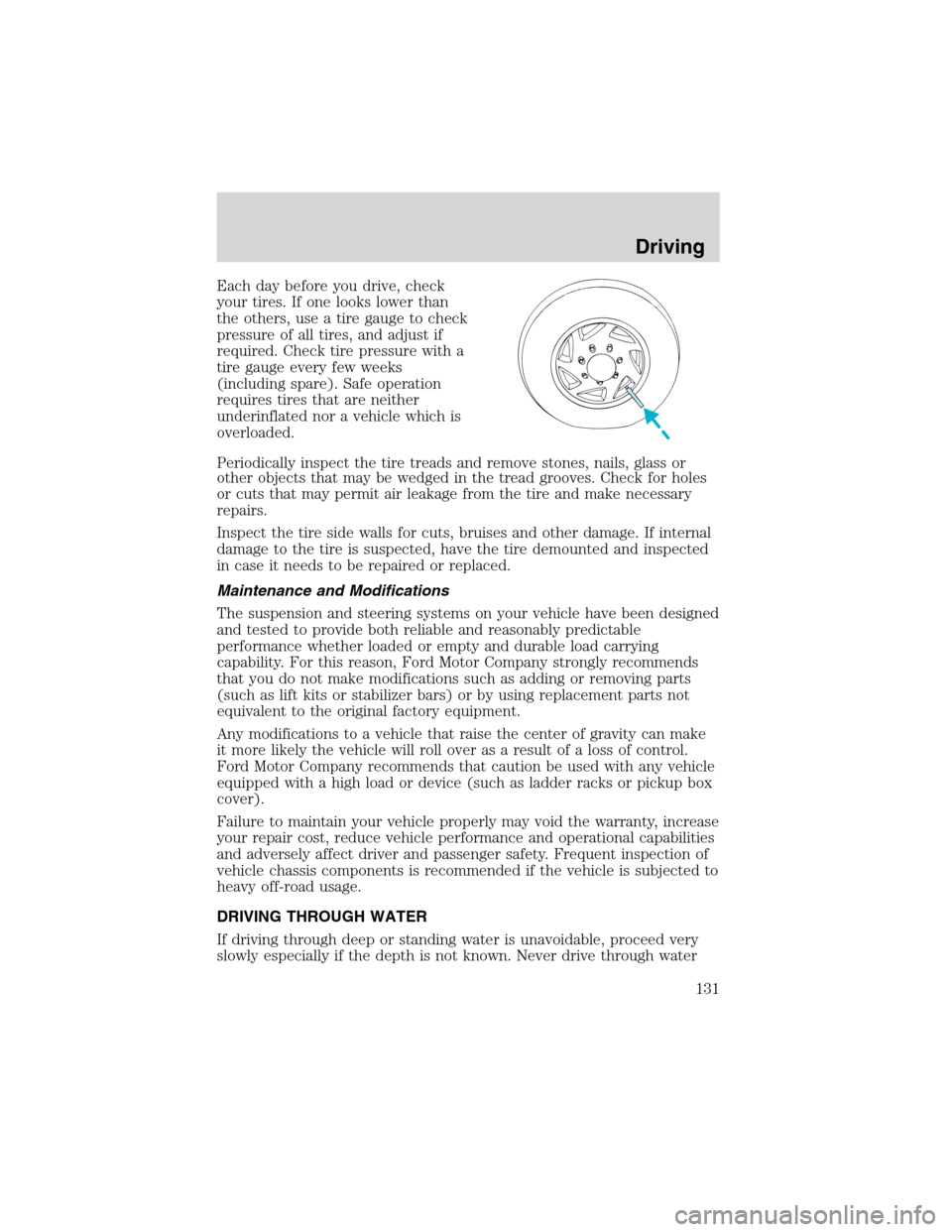
Each day before you drive, check
your tires. If one looks lower than
the others, use a tire gauge to check
pressure of all tires, and adjust if
required. Check tire pressure with a
tire gauge every few weeks
(including spare). Safe operation
requires tires that are neither
underinflated nor a vehicle which is
overloaded.
Periodically inspect the tire treads and remove stones, nails, glass or
other objects that may be wedged in the tread grooves. Check for holes
or cuts that may permit air leakage from the tire and make necessary
repairs.
Inspect the tire side walls for cuts, bruises and other damage. If internal
damage to the tire is suspected, have the tire demounted and inspected
in case it needs to be repaired or replaced.
Maintenance and Modifications
The suspension and steering systems on your vehicle have been designed
and tested to provide both reliable and reasonably predictable
performance whether loaded or empty and durable load carrying
capability. For this reason, Ford Motor Company strongly recommends
that you do not make modifications such as adding or removing parts
(such as lift kits or stabilizer bars) or by using replacement parts not
equivalent to the original factory equipment.
Any modifications to a vehicle that raise the center of gravity can make
it more likely the vehicle will roll over as a result of a loss of control.
Ford Motor Company recommends that caution be used with any vehicle
equipped with a high load or device (such as ladder racks or pickup box
cover).
Failure to maintain your vehicle properly may void the warranty, increase
your repair cost, reduce vehicle performance and operational capabilities
and adversely affect driver and passenger safety. Frequent inspection of
vehicle chassis components is recommended if the vehicle is subjected to
heavy off-road usage.
DRIVING THROUGH WATER
If driving through deep or standing water is unavoidable, proceed very
slowly especially if the depth is not known. Never drive through water
Driving
131
Page 132 of 248
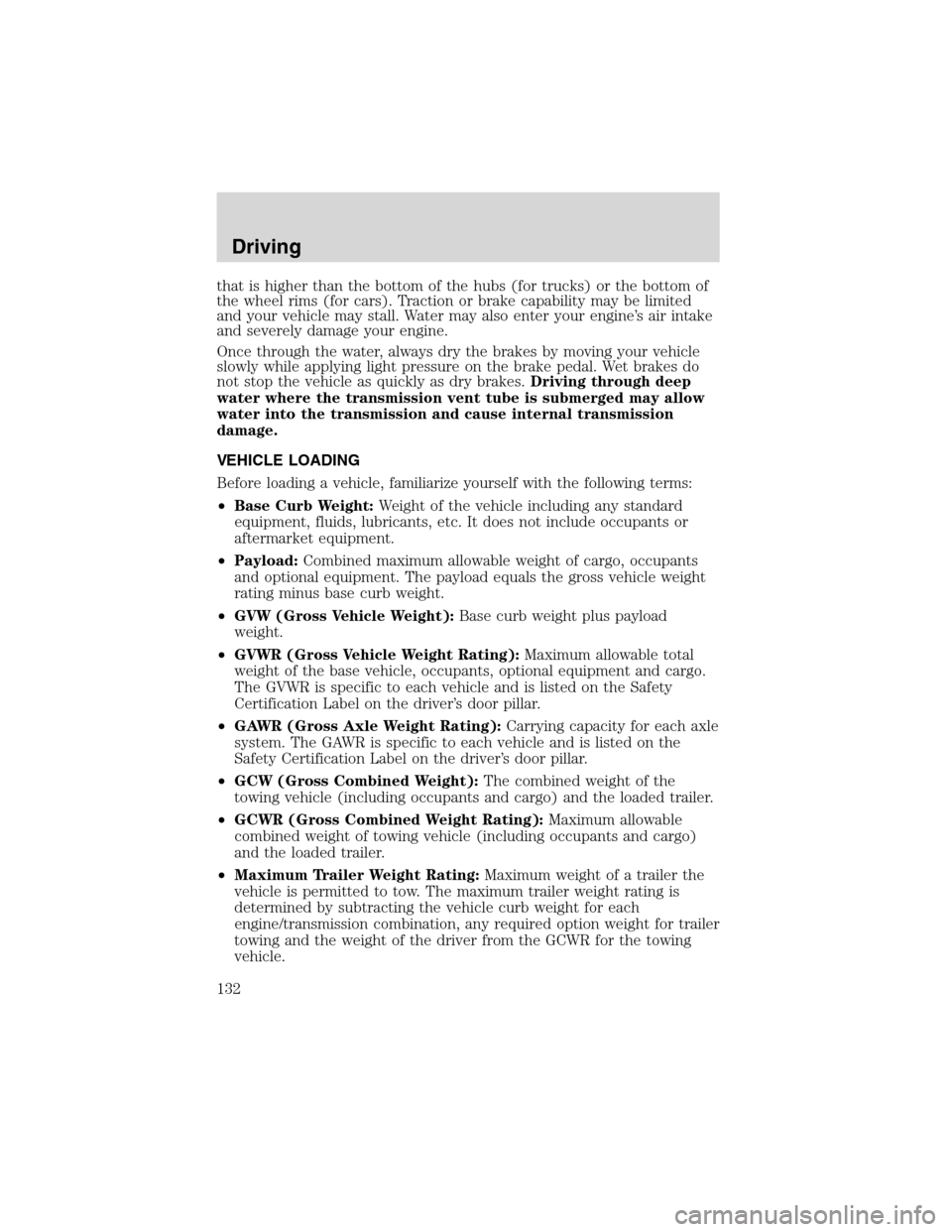
that is higher than the bottom of the hubs (for trucks) or the bottom of
the wheel rims (for cars). Traction or brake capability may be limited
and your vehicle may stall. Water may also enter your engine’s air intake
and severely damage your engine.
Once through the water, always dry the brakes by moving your vehicle
slowly while applying light pressure on the brake pedal. Wet brakes do
not stop the vehicle as quickly as dry brakes.Driving through deep
water where the transmission vent tube is submerged may allow
water into the transmission and cause internal transmission
damage.
VEHICLE LOADING
Before loading a vehicle, familiarize yourself with the following terms:
•Base Curb Weight:Weight of the vehicle including any standard
equipment, fluids, lubricants, etc. It does not include occupants or
aftermarket equipment.
•Payload:Combined maximum allowable weight of cargo, occupants
and optional equipment. The payload equals the gross vehicle weight
rating minus base curb weight.
•GVW (Gross Vehicle Weight):Base curb weight plus payload
weight.
•GVWR (Gross Vehicle Weight Rating):Maximum allowable total
weight of the base vehicle, occupants, optional equipment and cargo.
The GVWR is specific to each vehicle and is listed on the Safety
Certification Label on the driver’s door pillar.
•GAWR (Gross Axle Weight Rating):Carrying capacity for each axle
system. The GAWR is specific to each vehicle and is listed on the
Safety Certification Label on the driver’s door pillar.
•GCW (Gross Combined Weight):The combined weight of the
towing vehicle (including occupants and cargo) and the loaded trailer.
•GCWR (Gross Combined Weight Rating):Maximum allowable
combined weight of towing vehicle (including occupants and cargo)
and the loaded trailer.
•Maximum Trailer Weight Rating:Maximum weight of a trailer the
vehicle is permitted to tow. The maximum trailer weight rating is
determined by subtracting the vehicle curb weight for each
engine/transmission combination, any required option weight for trailer
towing and the weight of the driver from the GCWR for the towing
vehicle.
Driving
132
Page 133 of 248
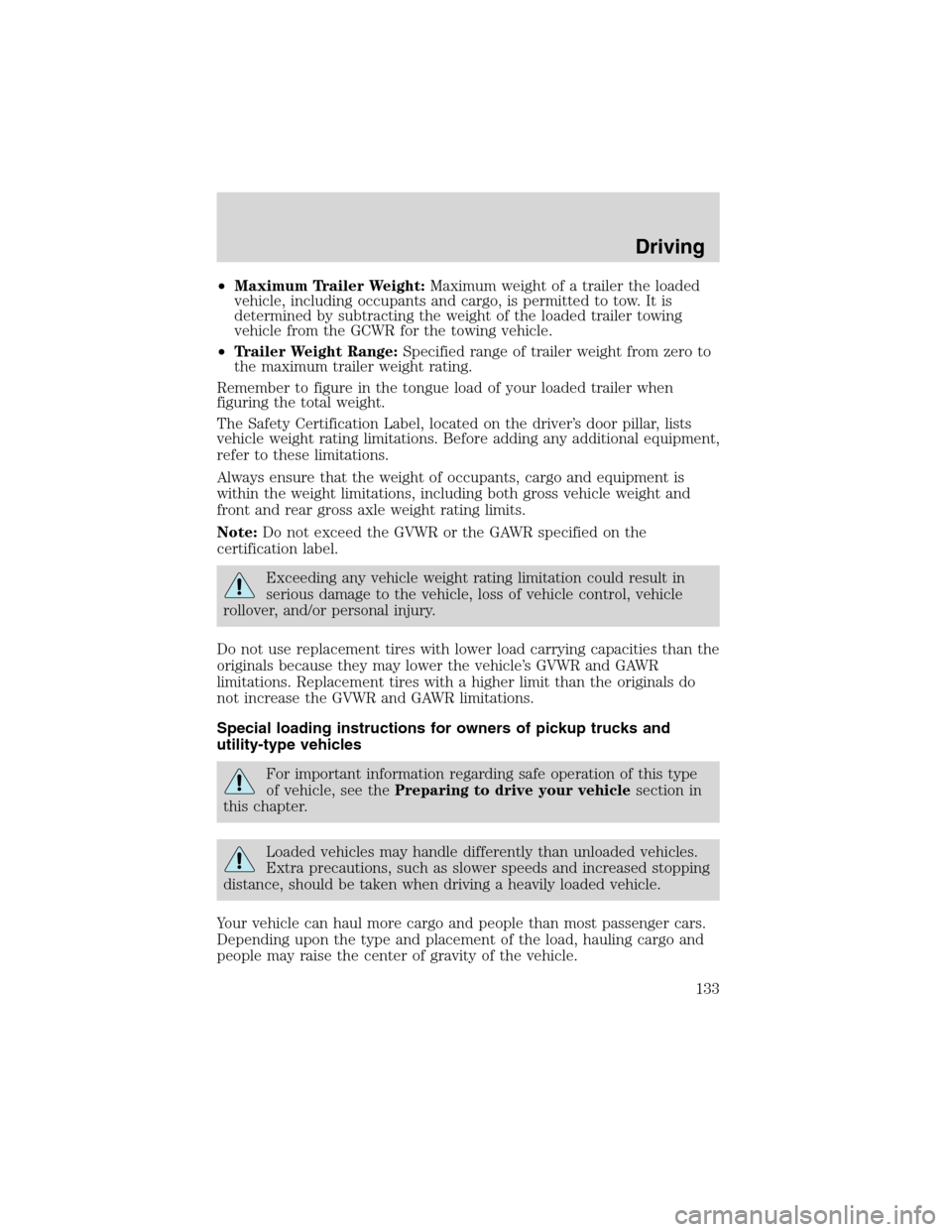
•Maximum Trailer Weight:Maximum weight of a trailer the loaded
vehicle, including occupants and cargo, is permitted to tow. It is
determined by subtracting the weight of the loaded trailer towing
vehicle from the GCWR for the towing vehicle.
•Trailer Weight Range:Specified range of trailer weight from zero to
the maximum trailer weight rating.
Remember to figure in the tongue load of your loaded trailer when
figuring the total weight.
The Safety Certification Label, located on the driver’s door pillar, lists
vehicle weight rating limitations. Before adding any additional equipment,
refer to these limitations.
Always ensure that the weight of occupants, cargo and equipment is
within the weight limitations, including both gross vehicle weight and
front and rear gross axle weight rating limits.
Note:Do not exceed the GVWR or the GAWR specified on the
certification label.
Exceeding any vehicle weight rating limitation could result in
serious damage to the vehicle, loss of vehicle control, vehicle
rollover, and/or personal injury.
Do not use replacement tires with lower load carrying capacities than the
originals because they may lower the vehicle’s GVWR and GAWR
limitations. Replacement tires with a higher limit than the originals do
not increase the GVWR and GAWR limitations.
Special loading instructions for owners of pickup trucks and
utility-type vehicles
For important information regarding safe operation of this type
of vehicle, see thePreparing to drive your vehiclesection in
this chapter.
Loaded vehicles may handle differently than unloaded vehicles.
Extra precautions, such as slower speeds and increased stopping
distance, should be taken when driving a heavily loaded vehicle.
Your vehicle can haul more cargo and people than most passenger cars.
Depending upon the type and placement of the load, hauling cargo and
people may raise the center of gravity of the vehicle.
Driving
133
Page 134 of 248

Calculating the load your vehicle can carry/tow
1. Use the appropriate maximum GCWR chart (in theTrailer Towing
section in this chapter) for your type of engine and rear axle ratio.
2. Weigh your vehicle without cargo. To obtain correct weights, take your
vehicle to a shipping company or an inspection station for trucks.
3. Subtract your loaded weight from the maximum GCWR in the chart.
This is the maximum trailer weight your vehicle can tow. It must be
below the maximum trailer weight shown in the chart.
TRAILER TOWING
Your vehicle may tow a class I, II or III trailer provided the maximum
trailer weight is less than or equal to the maximum trailer weight listed
for your engine and rear axle ratio on the following charts.
Your vehicle’s load capacity is designated by weight, not by volume, so
you cannot necessarily use all available space when loading a vehicle.
Towing a trailer places an additional load on your vehicle’s engine,
transmission, axle, brakes, tires and suspension. Inspect these
components carefully after any towing operation.
4x2 w/manual transmission
Engine Rear
axle
ratioMaximum
GCWR - kg
(lbs.)Maximum
trailer
weight - kg
(lbs.)Maximum
frontal
area of
trailer - m
2
(ft2)
Regular Cab w/6’box
2.3L All 2177 (4800) 753 (1660) Equal to
frontal area
of vehicle
3.0L
(non-torsion
bar
suspension)All 2722 (6000) 1207 (2660) 4.64 (50)
3.0L
(torsion bar
suspension)All 2722 (6000) 1152 (2540) 4.64 (50)
Driving
134
Page 135 of 248
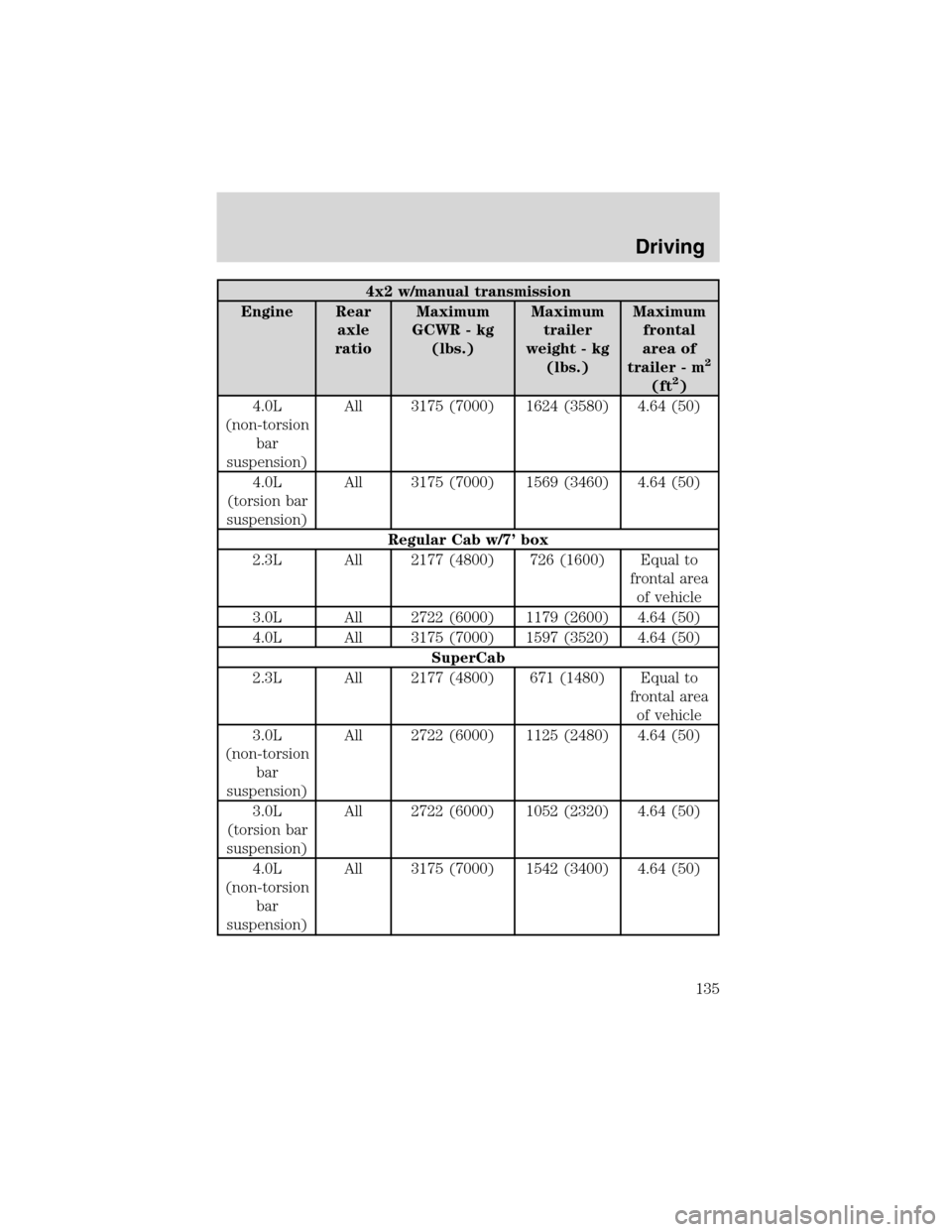
4x2 w/manual transmission
Engine Rear
axle
ratioMaximum
GCWR - kg
(lbs.)Maximum
trailer
weight - kg
(lbs.)Maximum
frontal
area of
trailer - m
2
(ft2)
4.0L
(non-torsion
bar
suspension)All 3175 (7000) 1624 (3580) 4.64 (50)
4.0L
(torsion bar
suspension)All 3175 (7000) 1569 (3460) 4.64 (50)
Regular Cab w/7’box
2.3L All 2177 (4800) 726 (1600) Equal to
frontal area
of vehicle
3.0L All 2722 (6000) 1179 (2600) 4.64 (50)
4.0L All 3175 (7000) 1597 (3520) 4.64 (50)
SuperCab
2.3L All 2177 (4800) 671 (1480) Equal to
frontal area
of vehicle
3.0L
(non-torsion
bar
suspension)All 2722 (6000) 1125 (2480) 4.64 (50)
3.0L
(torsion bar
suspension)All 2722 (6000) 1052 (2320) 4.64 (50)
4.0L
(non-torsion
bar
suspension)All 3175 (7000) 1542 (3400) 4.64 (50)
Driving
135
Page 136 of 248
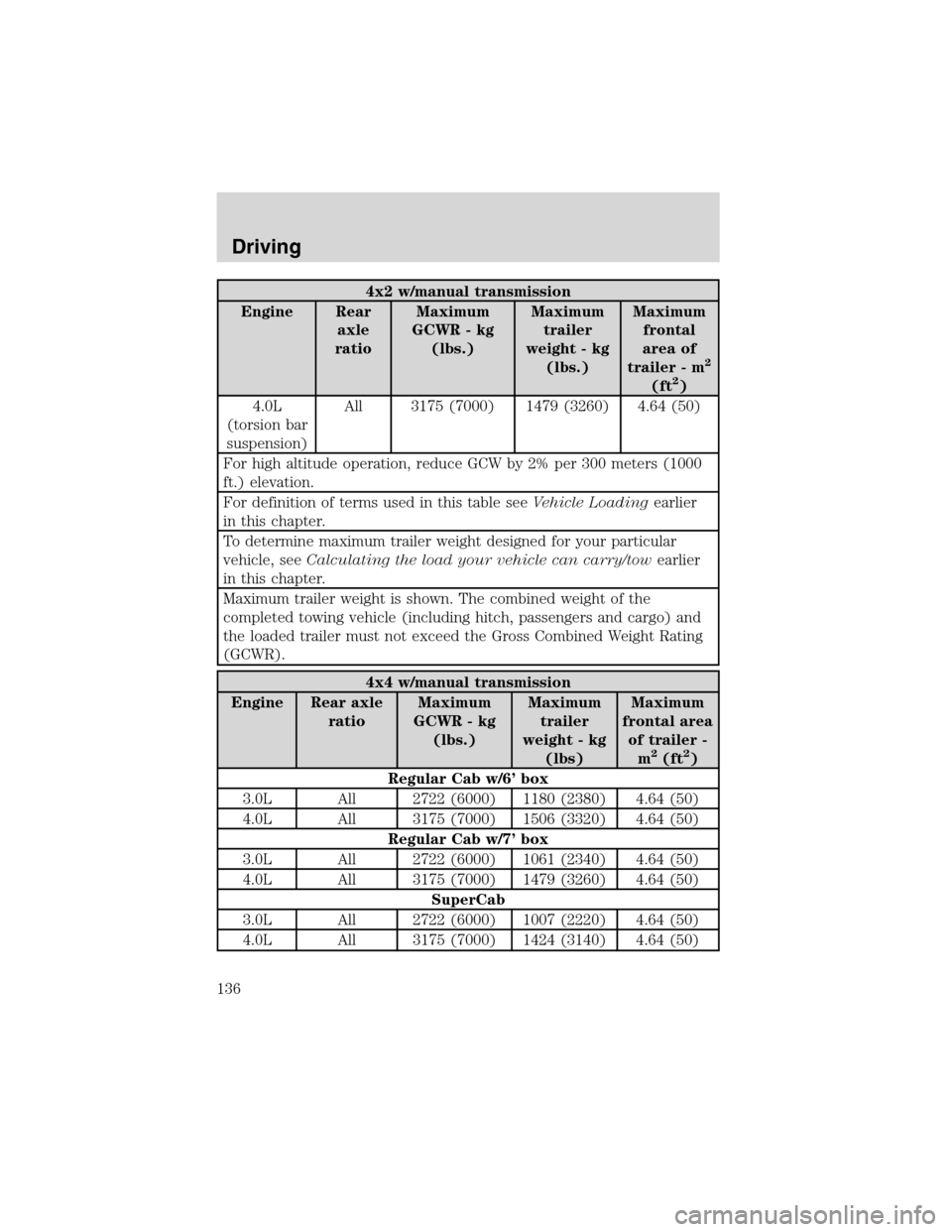
4x2 w/manual transmission
Engine Rear
axle
ratioMaximum
GCWR - kg
(lbs.)Maximum
trailer
weight - kg
(lbs.)Maximum
frontal
area of
trailer - m
2
(ft2)
4.0L
(torsion bar
suspension)All 3175 (7000) 1479 (3260) 4.64 (50)
For high altitude operation, reduce GCW by 2% per 300 meters (1000
ft.) elevation.
For definition of terms used in this table seeVehicle Loadingearlier
in this chapter.
To determine maximum trailer weight designed for your particular
vehicle, seeCalculating the load your vehicle can carry/towearlier
in this chapter.
Maximum trailer weight is shown. The combined weight of the
completed towing vehicle (including hitch, passengers and cargo) and
the loaded trailer must not exceed the Gross Combined Weight Rating
(GCWR).
4x4 w/manual transmission
Engine Rear axle
ratioMaximum
GCWR - kg
(lbs.)Maximum
trailer
weight - kg
(lbs)Maximum
frontal area
of trailer -
m
2(ft2)
Regular Cab w/6’box
3.0L All 2722 (6000) 1180 (2380) 4.64 (50)
4.0L All 3175 (7000) 1506 (3320) 4.64 (50)
Regular Cab w/7’box
3.0L All 2722 (6000) 1061 (2340) 4.64 (50)
4.0L All 3175 (7000) 1479 (3260) 4.64 (50)
SuperCab
3.0L All 2722 (6000) 1007 (2220) 4.64 (50)
4.0L All 3175 (7000) 1424 (3140) 4.64 (50)
Driving
136
Page 137 of 248
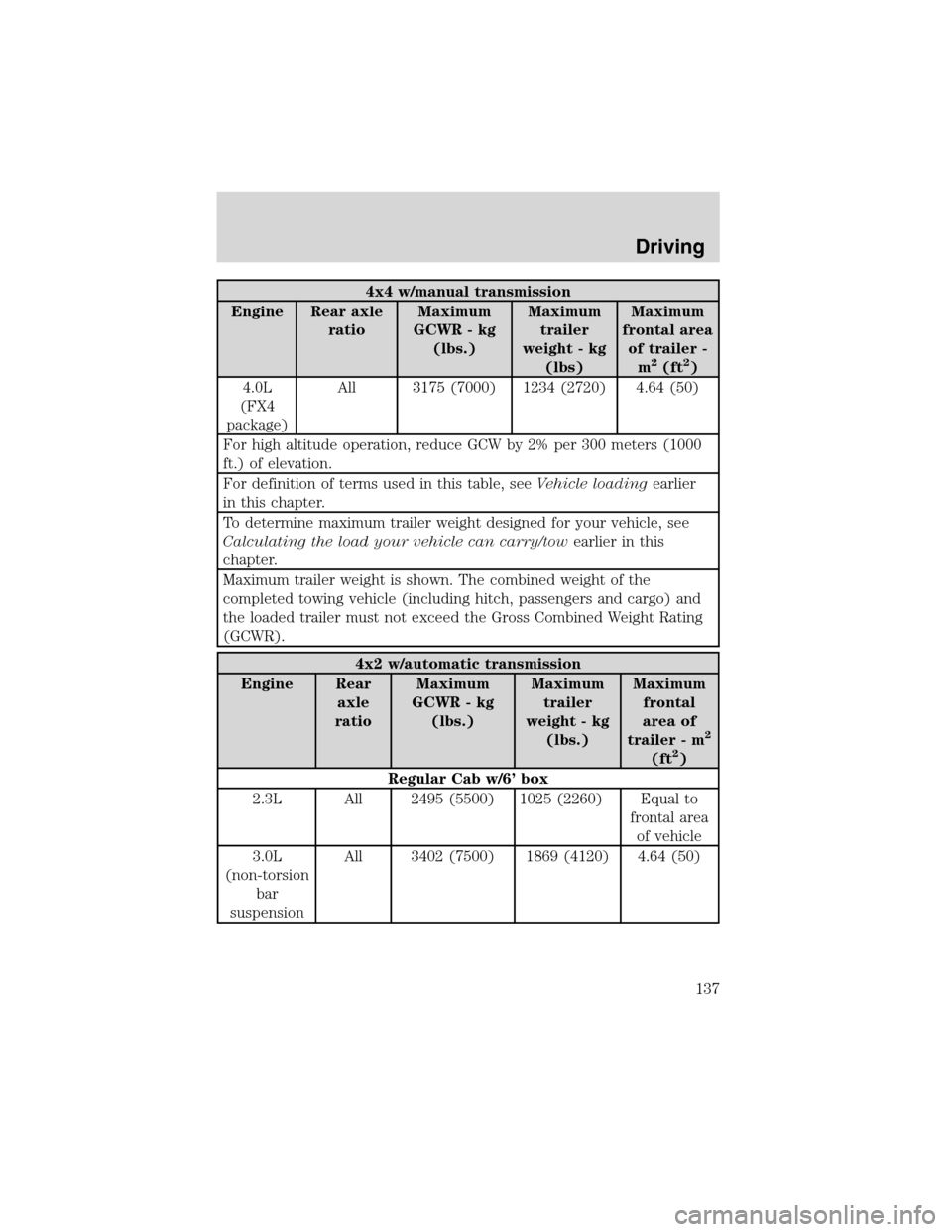
4x4 w/manual transmission
Engine Rear axle
ratioMaximum
GCWR - kg
(lbs.)Maximum
trailer
weight - kg
(lbs)Maximum
frontal area
of trailer -
m
2(ft2)
4.0L
(FX4
package)All 3175 (7000) 1234 (2720) 4.64 (50)
For high altitude operation, reduce GCW by 2% per 300 meters (1000
ft.) of elevation.
For definition of terms used in this table, seeVehicle loadingearlier
in this chapter.
To determine maximum trailer weight designed for your vehicle, see
Calculating the load your vehicle can carry/towearlier in this
chapter.
Maximum trailer weight is shown. The combined weight of the
completed towing vehicle (including hitch, passengers and cargo) and
the loaded trailer must not exceed the Gross Combined Weight Rating
(GCWR).
4x2 w/automatic transmission
Engine Rear
axle
ratioMaximum
GCWR - kg
(lbs.)Maximum
trailer
weight - kg
(lbs.)Maximum
frontal
area of
trailer - m
2
(ft2)
Regular Cab w/6’box
2.3L All 2495 (5500) 1025 (2260) Equal to
frontal area
of vehicle
3.0L
(non-torsion
bar
suspensionAll 3402 (7500) 1869 (4120) 4.64 (50)
Driving
137
Page 138 of 248

4x2 w/automatic transmission
Engine Rear
axle
ratioMaximum
GCWR - kg
(lbs.)Maximum
trailer
weight - kg
(lbs.)Maximum
frontal
area of
trailer - m
2
(ft2)
3.0L
(torsion bar
suspension)All 3402 (7500) 1814 (4000) 4.64 (50)
4.0L
(non-torsion
bar
suspension)All 4309 (9500) 2740 (6040) 4.64 (50)
4.0L
(torsion bar
suspension)All 4309 (9500) 2685 (5920) 4.64 (50)
Regular Cab w/7’box
2.3L All 2495 (5500) 1007 (2220) Equal to
frontal area
of vehicle
3.0L All 3402 (7500) 1842 (4060) 4.64 (50)
4.0L All 4309 (9500) 2712 (5980) 4.64 (50)
SuperCab
3.0L
(non-torsion
bar
suspension)All 3402 (7500) 1787 (3940) 4.64 (50)
3.0L
(torsion bar
suspension)All 3402 (7500) 1715 (3780) 4.64 (50)
4.0L
(non-torsion
bar
suspension)All 4309 (9500) 2667 (5880) 4.64 (50)
Driving
138
Page 139 of 248

4x2 w/automatic transmission
Engine Rear
axle
ratioMaximum
GCWR - kg
(lbs.)Maximum
trailer
weight - kg
(lbs.)Maximum
frontal
area of
trailer - m
2
(ft2)
4.0L
(torsion bar
suspension)All 4309 (9500) 2595 (5720) 4.64 (50)
For high altitude operation, reduce GCW by 2% per 300 meters (1000
ft.) elevation.
For definition of terms used in this table seeVehicle Loadingearlier
in this chapter.
To determine maximum trailer weight designed for your particular
vehicle, seeCalculating the load your vehicle can carry/towearlier
in this chapter.
Maximum trailer weight is shown. The combined weight of the
completed towing vehicle (including hitch, passengers and cargo) and
the loaded trailer must not exceed the Gross Combined Weight Rating
(GCWR).
4x4 w/automatic transmission
Engine Rear axle
ratioMaximum
GCWR - kg
(lbs.)Maximum
trailer
weight - kg
(lbs.)Maximum
frontal area
of trailer -
m
2(ft2)
Regular Cab w/6’box
3.0L All 3402 (7500) 1751 (3860) 4.64 (50)
4.0L All 4309 (9500) 2622 (5780) 4.64 (50)
Regular Cab w/7’box
3.0L All 3402 (7500) 1724 (3800) 4.64 (50)
4.0L All 4309 (9500) 2595 (5720) 4.64 (50)
SuperCab
3.0L All 3402 (7500) 1669 (3680) 4.64 (50)
4.0L All 4309 (9500) 2540 (5600) 4.64 (50)
Driving
139
Page 140 of 248
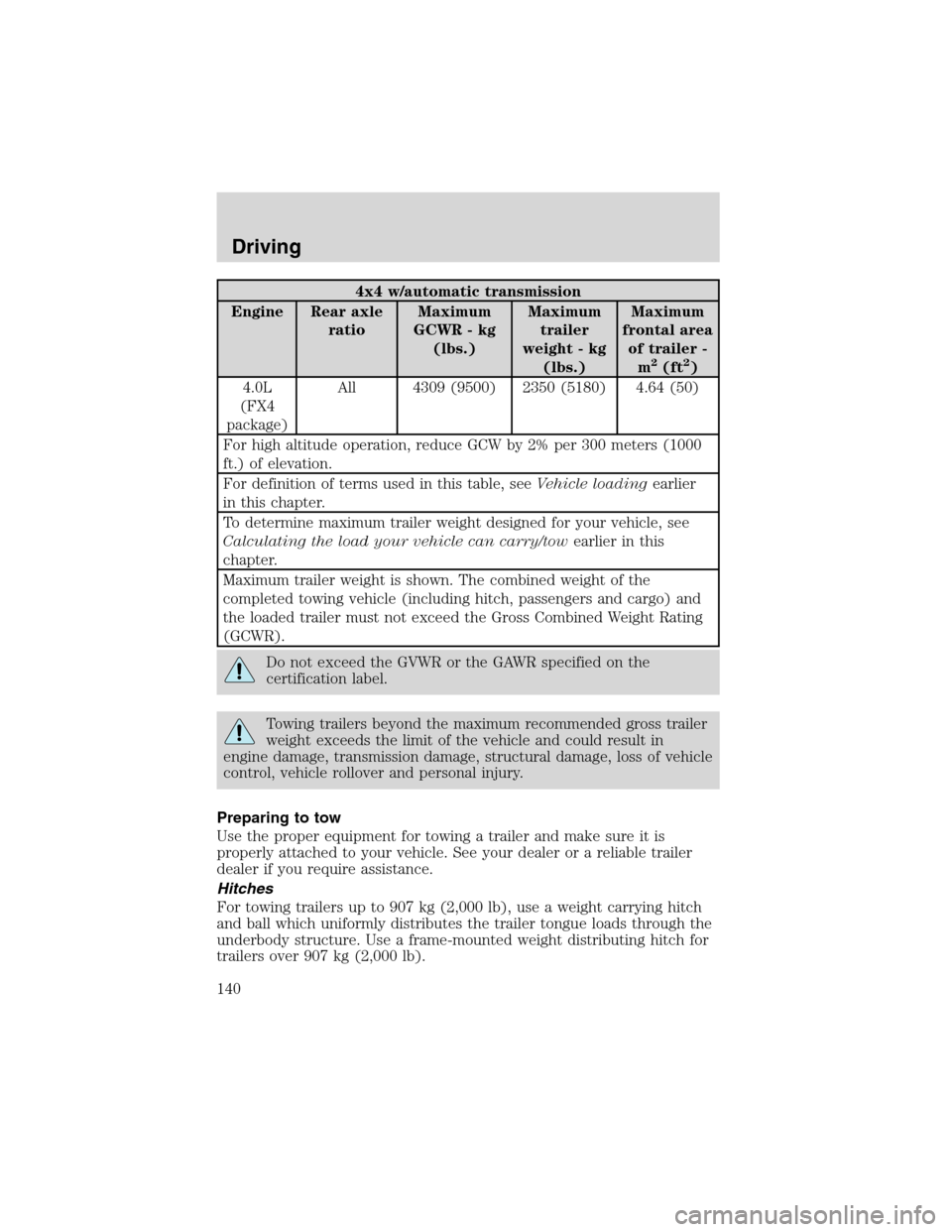
4x4 w/automatic transmission
Engine Rear axle
ratioMaximum
GCWR - kg
(lbs.)Maximum
trailer
weight - kg
(lbs.)Maximum
frontal area
of trailer -
m
2(ft2)
4.0L
(FX4
package)All 4309 (9500) 2350 (5180) 4.64 (50)
For high altitude operation, reduce GCW by 2% per 300 meters (1000
ft.) of elevation.
For definition of terms used in this table, seeVehicle loadingearlier
in this chapter.
To determine maximum trailer weight designed for your vehicle, see
Calculating the load your vehicle can carry/towearlier in this
chapter.
Maximum trailer weight is shown. The combined weight of the
completed towing vehicle (including hitch, passengers and cargo) and
the loaded trailer must not exceed the Gross Combined Weight Rating
(GCWR).
Do not exceed the GVWR or the GAWR specified on the
certification label.
Towing trailers beyond the maximum recommended gross trailer
weight exceeds the limit of the vehicle and could result in
engine damage, transmission damage, structural damage, loss of vehicle
control, vehicle rollover and personal injury.
Preparing to tow
Use the proper equipment for towing a trailer and make sure it is
properly attached to your vehicle. See your dealer or a reliable trailer
dealer if you require assistance.
Hitches
For towing trailers up to 907 kg (2,000 lb), use a weight carrying hitch
and ball which uniformly distributes the trailer tongue loads through the
underbody structure. Use a frame-mounted weight distributing hitch for
trailers over 907 kg (2,000 lb).
Driving
140